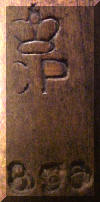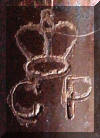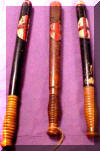City of London Police
Handcuffs and Truncheons
City of London Police Handcuffs
In the early 1800’s, Hiatt’s in Birmingham started
supplying most of the Handcuffs and leg irons to British Police Forces. The
City of London was no exception. A few styles of the various types supplied
over the years are listed below.
Hiatt-Darby 104-Nickel Single Locking position Handcuffs
Single locking position, non-adjusting Darby handcuffs.
This set of handcuffs were manufactured by Hiatt in the late 19th
century. This set are handcuffs are stamped Hiatt Best, Warranted Wrought
and the key is stamped Hiatt along with a three digit number which is
believed to be the Officer’s Divisional number stamped onto the key. (Fig.
77)

Hiatt’s 1960 Pattern Handcuffs
These curiously curved cuffs were bright and chrome
plated. The Hiatt Model 1960, while never really popular, did serve to
acquaint the British Police Community with the swing- through handcuff. They
were also the first ratchet style handcuff used by the British Police. The
handcuffs were stamped “British Made, Hiatts 1960” with the serial number
and were stamped with the Force name on one of the cuffs. The Model 1960,
were among the very few handcuffs,which was produced with a round keyhole.
(Fig. 78)

Hiatt’s 1970 Pattern Handcuffs
These handcuffs are pretty standard and are similar to
the Peerless and Smith & Wesson styles made for Law Enforcement in the
United States/Canada. The serial number and force name are stamped onto the
Handcuffs. As well the handcuff key was much smaller than the key for the
1960 Model. (Fig.79)

Hiatt’s 2003 Handcuffs
This style handcuff I believed was issued in the mid
80’s. It is similar to the 1970 pattern however this style is unusual
because there is a metal plug held in place by two rivets in the bow of the
handcuff. This adds strength and weight to the handcuff. Again the serial
number, and the words Hiatts as well as the force name is stamped on the one
cuff. The same key as used with the Hiatts 1970 Model could also be used
with these cuffs. (Fig. 80)

Hiatt’s CDS Quick Cuffs (Rigid Cuffs)
The quick cuffs or rigid cuffs as they are also referred,
were first issued to the British Police in 1993. These cuffs are
particularly effective as only one cuff is needed to be on, and Officers can
then apply pressure to control their subjects. They are basically a model
2003 handcuff with a four finger plastic handle or grip in the center of the
handcuffs. There have been a few different styles since they were first
introduced in 1993. The Hiatt stamp is seen in the center of the plastic
piece and the serial number is on one of the cuffs. I have not seen any with
the force name engraved on the cuff, but the plastic is usually engraved
with the officer’s ID number. The handcuffs are seated in a pouch upright on
the officer’s belt. The same key can be used as the previous two models.
(Fig. 81)

City of London Truncheons
There are various styles and shapes of Police Truncheons,
which have been issued to the British Police over the years. The City of
London is no exception to the various styles and types used by the force
over the years. From the 17th Century onwards, the decorating of
Truncheons became more common. There are some very nice and ornate samples
in the City of London Police Museum as well as the City owned Museum of
London.
I have been fortunate enough to obtain a couple different
varieties, which are described below.
Queen Victoria Era Truncheon
This is an older style truncheon, which is believed to
have been used by the City of London Police from the late 1800’s – early
1900’s. The top of the truncheon has the Queen Victoria crown along with the
letters CP (City Police) This truncheon has a three digit badge number,
however there is no divisional letter on the top of the truncheon. The City
of London Police did not use divisional letters until after 1910.This
truncheon also has two different numbers along with different divisional
letters stamped on the truncheon as well indicating it was issued to two
other City Officers throughout it’s years of use! A very nice older piece
(Fig. 82, 82a)


City of London Special Constable Painted Truncheon
Prior to 1800 the services of Special Constables were
only occasionally called upon. With many riots in the 19th
century, they were called upon in an increasingly important part. Through
out the country, there were widespread strikes and disturbances. The Special
Constables were called upon to assist the regular officers in policing the
disputes. Sometimes the Specials were issued their own truncheons, however
often they had to supply their own truncheons, which were often were very
crude and were often nothing more than shaved down table legs or turned
pieces of wood. Sometimes they would hand paint their own designs onto the
truncheons. These often very ornate and beautiful pieces have become very
collectable. One style, which I was fortunate enough to obtain several years
ago, is a City of London S.C (Special Constable) hand painted truncheon. The
Special’s ID number is on the truncheon and is G.R. George V (1936-38) or
George VI (1938-52) (Fig.83)

City of London Police Painted Truncheon EIIR
This painted truncheon I believe is a reproduction of an
old painted City of London Police truncheon. Although the truncheon itself
is quite old, I believe this is a reproduction of an old style painted
truncheon. However it is quite nicely done, so I have included it. (Fig.
84)

City of London Standard Truncheon
This is the last style of the standard wooden Police
truncheon, which was used by the City of London Police. This truncheon also
has the stamping of the Crown at the top of the truncheon, with the letters
CP (City Police) This style was used from the early 1940's up until the mid
1990's when the City adopted the current ASP Baton (Expandable baton) . This
particular model was made by the J.Hudson & Co. of Birmingham . (Fig. 85,
85a)


Three more examples of early City of London Truncheons.
These painted truncheons, were most likely used by
Special Constables. The two truncheons with black paint on the handles, were
most likely made for the Chartist Riots of 1848. The one truncheon is
stamped in the butt of the handle “Parker 233 Holborn”. This indicates that
it is pre 1841.
The brown colored truncheon has the initials “SC”
(Special Constable) and the letters S.S.D. These letters possibly stand for
“Special Sergeant” or “Section Sergeant” for D Division.




ASP Expandable Baton
Due to the conflicts, which the British Police were
subject to in the mid to late 1990’s, the City of London Police along with a
lot of other British Police Forces decided to adopt the ASP Baton to better
equip their Officers.
The City adopted a 21” ASP baton, which is worn upright
on their duty belts. This baton enables the officers to quickly remove and
expand the ASP from the holder to protect themselves from threats, which
they encounter.
Although not standard on all of the City ASP Batons, a City of London Police
crested cap is available and can be screwed onto the butt of the baton for
quick identity.
(Fig. 86,86a)



